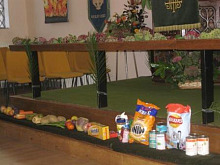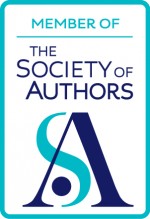Do I really need to have a website?
I don’t know, but my guess is that if you’re asking the question then perhaps the answer’s yes – especially if you’re at the stage of wanting to achieve the following aims:
- building your credibility as a potential author with agents, editors and likely readers, and
- connecting with like-minded people who will buy your work and/or be referrers of your work (also known as an author platform these days)
So this post is especially for new and emerging writers who are hovering nervously on the brink of deciding whether or not to have a website. (In follow-up posts I’ll look at more technical stuff but for now it’ll be pain-free, I promise.)
One step at a time

All is safely gathered in...
Where to start? Forget any anxieties about html coding and file transfer protocols. None of that matters for the moment. The first step is to collect all your assets together. By ‘assets’ I mean all the bits and pieces of information that you might need for your new website. And, as it’s the harvest season, there couldn’t be a more perfect time to gather in what marketing expert C.J. Hayden calls your success ingredients. I love that term – so American and dynamic!
#1 Author Photos You need an author pic – one at least, but a few more would be even better. Either hire a professional – go on, you’re worth it – or take the cost-effective DIY approach. In the latter case, an excellent and user-friendly online tool is Picnik. Here you can upload your photos for free and do the basics of image editing: cropping, resizing and adding special effects. (Don’t make yourself look too gorgeous though, or we won’t recognise you at your book launch. And you may attract stalkers.) You could also check out the advice from Salt Publishing in their 10 Ways to Take a Bad Author Photo.
#2 A Longer Bio
Gone are the days when writers could be all deep and mysterious; it seems we’re expected to give at least the bare bones of our life story. There are different formats, like Questions and Answers, or 12 Things You Didn’t Know About… , as well as a simple and straightforward narrative. (N.B. Longer Bios are not to be confused with the Shorter Bio of around 60 words that you also need.)
#3 List of writing credits
This should include the writing you’ve published so far; writing courses and qualifications; professional engagements; prizes or awards … really, anything that will enhance your reputation and suggest to the casual browser of your website that you’re to be taken seriously.
#4 List of possible links
Who are the people you’d want to link to? Friends and colleagues in your field? Opinion-makers whose work you admire? Even better if your list includes people who are prepared to reciprocate by linking back to you.
#5 Reviews / Endorsements
These are one of the most powerful forms of marketing you can get. Here’s a secret: I’m really shy when it comes to repeating nice things people have said about my writing. (It’s my childhood conditioning I guess, although – oddly – I’m not at all embarrassed by some of the testimonials I’ve received through my business, here and here.) Okay, I have issues to work on but don’t let that stop you.
#6 Notes on your personal brand
You will either loathe or adore this part, but an awareness of your ‘personal brand’ is helpful when you get down to designing your website, or briefing a web designer. Why? Because you want to make sure that your website reflects who you are, through your use of colour, fonts, images, etc.
That’s a lot to be getting on with. Next time, I’ll look at domain registration, static vs. blog websites, and doing a basic storyboard.
Do you want or need a website, or are you determined not to have one? Have I missed out any success ingredients? If you’re a new/emerging writer with your own website, tell us how it’s working for you.
Fiona Joseph


9 Comments
Nice opening gambit, Flo-Joe!
I only have experience of blogging rather than having a proper website, which suggests something more permanent and with more links and content areas, so I can only talk about what I think you need for a successful blog. The following is a combination of my own ideas and things suggested to me by successful bloggers in my field.
Whilist points 1-5 are important to explain who you are and what you do, point 6 is the one new bloggers should really focus on.
You have to accept the awful truth that people will only dip into your blog if they think there is something interesting there, so (a) you have to advertise – using twitter, facebook, catch-all emails etc – to gain an audience, and (b) the advertisement has to have some kind of teaser in it.
I hate to say it, but the headlines on the Yahoo home page are the way to go in this respect. There is always a main story which has a ‘Find out more’ tag – and I for one always hit that tag, even if I hate myself for reading it if it’s trashy.
Some of my ELT editors have ‘accused’ me of having a tabloid mentality when it comes to materials, but I’m afraid the newspapers PLU don’t usually read have amazing ways of hooking their readers, through headline, image and opening line. Unfortunately, if you aren’t famous, it may be the way to go.
When I blog, I tweet a teaser (wow – I wouldn’t have made head nor tail of that phrase five years ago!). For example, my next blog will be a continuation of my last one about adapting improvisation comedy activities for teaching, but the one after that will be more generally about ELT drama activities.
The fact is I don’t like the word ‘drama’ to describe the activities I’m going to talk about. So my teaser-tweet will say: Why I hate ‘drama’. Coming from the former director of the English Teaching Theatre, that might cause some raised eyebrows (and therefore visits to my blog).
I’ll let you know if it works!
Best,
Ken
I loved the link to ’10 Ways to Take a Bad Author Photo’. Because self-publicity is hard, some people deliberately — childishly — create a bad image of themselves to indicate their scorn for PR. It’s not a good look.
Hi Ken, thanks for generously sharing your insights – all good and useful points for would be bloggers to consider.
Re: advertising, I think it’s Michael Hyatt (of Thomas Nelson) who refers to social networking tools like Facebook and Twitter as ‘gateposts’, i.e. forms of outreach that can direct people to what’s most important – your blog/website. It’s true, as one does need those readers and commentators; otherwise what’s the point?
Anyway, do pop back and give us regular updates on how your strategies are working. I love success stories!
Fiona
P.S. Glad it’s not just me who gets hooked every time by Yahoo News headlines.
~~~~~~~~~~~~~~~~~~~~~~~~~~~~~~~~~~~~~~~~~~~~~~~~~
Hi David, yes the ‘Bad Author Photo’ article’s hilarious!
You’re right, you get the impression that some people find the whole self-publicity thing a bit infra dig, or maybe it’s simply shyness.
What’s the best author photograph you’ve seen?
An excellent piece, Fiona, and thanks for the link to the Salt advice – nicely done (and reminds me to recommend Newman & Mittelmark’s ‘How not to write a novel’ for equally humorous but invaluable advice). For the next installment: I love those sites where something moves or happens when your cursor passes over without clicking, route-online used to have a great one (sadly now gone), I spent many a happy time of not-writing by trying to figure out what happened when I put the cursor there, or how far it needed to go in that direction to trigger that to happen, etc. I assume that is crazily expensive, and you’d have to pay a Bulgarian IT student almost the minimum wage to do it?
I liked the advice on biogs too. Thumbnail biogs of the writers at the back of a short story journal are often more entertaining than some of the stories, for entirely unintended reasons. Give them enough rope and they do the rest. Funny, the care a writer will take over the word perfect story (if the reader’s lucky), and then all critical faculties are switched off when the writer just gets a chance to talk about themselves…
Hi Andrew, I can see that you’re a widget kinda guy with your love of animated hotspots and the like!
And now that you mention it, the thumbnail biogs ARE quite tricky. Perhaps I’ll employ a ghostwriter to do my next one. What’s the going rate?
Wow! I’m learning so much from your website, keep up the good work,love kas
Thanks Kas, glad you’re finding it useful! Looking forward to seeing you soon. x
Just as a follow-up on personal branding (with a social media twist) there’s a brilliant YouTube video of Gary Vaynerchuk talking about the importance of passion in business. http://www.youtube.com/watch?v=EhqZ0RU95d4
A lot of what he says is of value to writers – but only if you’re passionate! Thanks @userfocus for sending this.